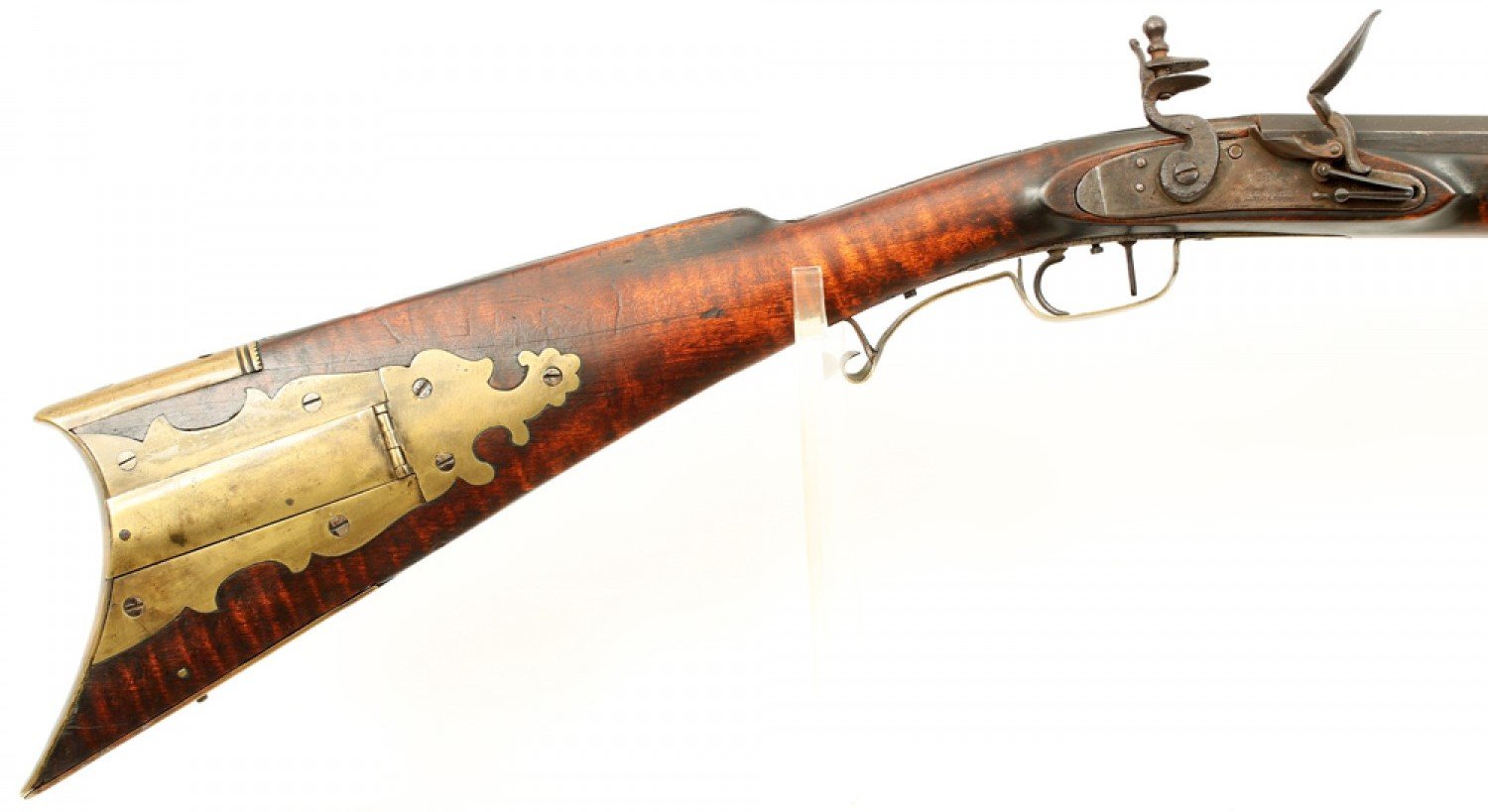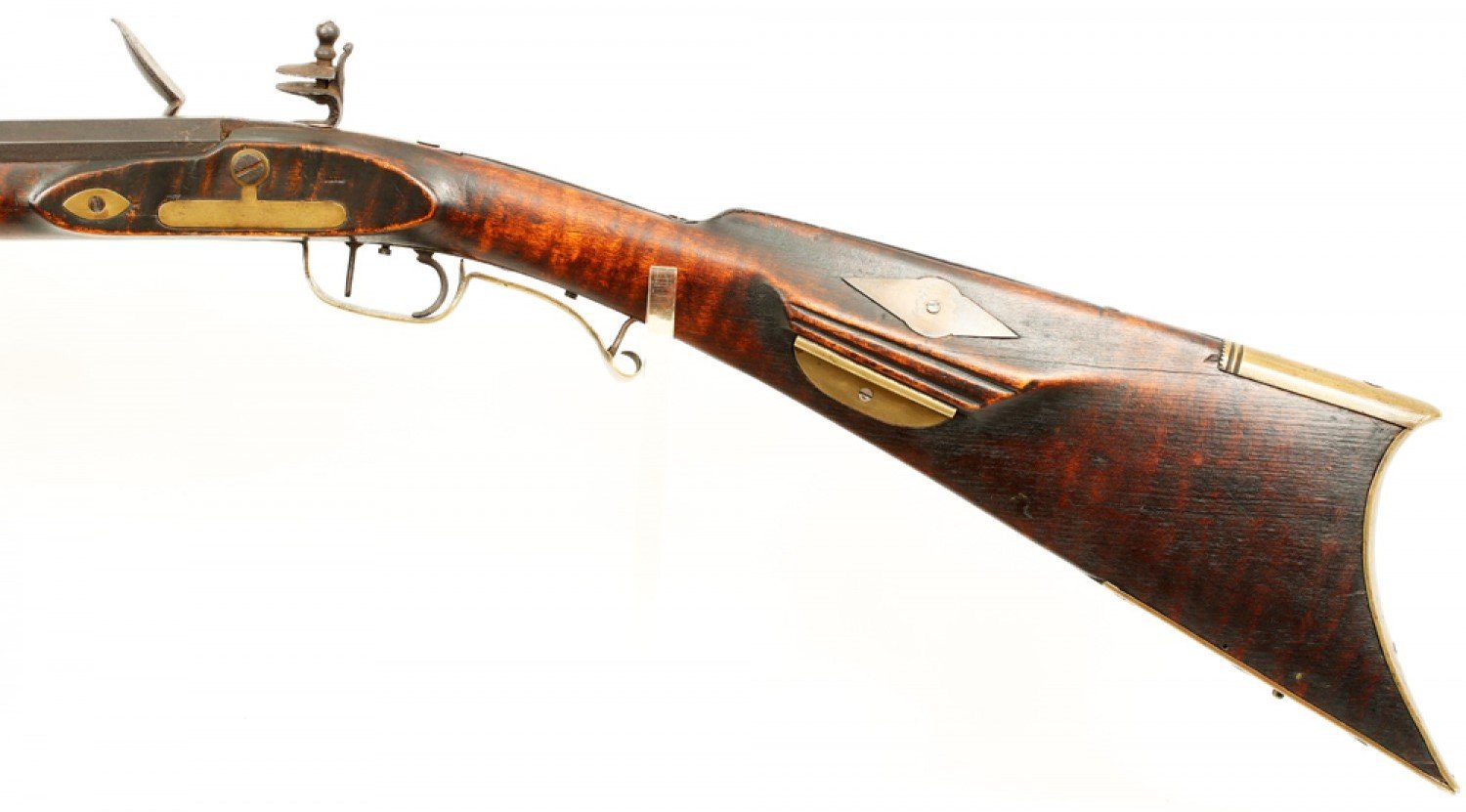A Mountain Rifle Masterpiece by Kentucky’s John Bull ©
Foreword: Most of Kentucky’s highly decorated rifles were made in or near its central Bluegrass region, while guns made in outlying areas were generally plainer. The southeastern Cumberland Plateau region, often called Kentucky’s “hill country,” developed more slowly than the rest of the state due to its rough terrain, less productive soils, and Scot-Irish settlers who preferred living in isolated areas. As a result, its mountain rifles were exceptionally plain, barely more than a roughly stocked barrel with locally forged iron furniture and often made in “poor boy” style without butt plate, rear pipe, or nose cap. Yet despite the area’s widespread poverty, a few gunsmiths made exceptional rifles. Arguably the two best mountain rifle gunmakers were Pleasant Wilson of Clay County and John Bull of Knox County. Of the two men, John Bull had a more interesting background and was the first of the great Bull family of gunsmiths in Tennessee and Kentucky.
Figure No.1: A full length view of the circa 1830 “John Bull” signed rifle shows its large brass patchbox with strong Lancaster, Pennsylvania, influences in the daisy headed finial. The patchbox seems out of place on a Kentucky gun, but near-by gunsmith William Hall of Floyd County, Kentucky, used a similar patchbox on a rifle in 1835. Note the distinctive Tennessee style guard with rolled rear spur, usually made of forged iron, but made of brass on the Bull rifle. A fine Pleasant Wilson rifle is shown below for comparison purposes. Barrel: 46-1/2” with .42 caliber bore. Author’s collection.
Figure No.2: An exceptional mountain rifle by gunsmith Pleasant Wilson of Clay County, Kentucky, a competitor to Bull, shows Tennessee influences in its iron furniture and slim stocking. Both Wilson and Bull worked within the Mountain Rifle School in southeastern Kentucky, but their work was much finer than the average mountain rifle from the area. Both guns have four ramrod pipes and silver forestock inlays, rare features on mountain rifles. Despite the significant butt plate curvature, this rifle dates to circa 1825. Barrel: 46” with .36 caliber bore. Author’s collection.
John Bull, First of a Legendary Family: Bull was born December 6, 1754, in Baltimore, Maryland, to parents John (1719-1757) and Hanna Bull. His younger brother Jacob (1756-1830) was the father of the better-known Bull gunsmiths John Valentine Bull and Elisha Bull of Bulls Gap, Tennessee, and Jesse Bull of Harlan County, Kentucky. John Bull served in the Revolutionary War and received bounty land warrants which he used to acquire land in Greene County, North Carolina by/before 1783. The area later became Greene County, Tennessee, in 1796. He married a Cherokee woman known as Jemima, and together they raised a family. In 1792 “gunsmith John Bull” received a North Carolina land grant for 55 acres of land on Bays Mountain in Greene County, near/at an important east-west passage through the mountains. He operated the first stage/freight line through the passage, and it became known as Bulls Gap. John also ran a gun shop at Bulls Gap, servicing local citizens and travelers. He was the first Bull family gunsmith to work at Bulls Gap [followed by other Bull family gunsmiths] and maintained his gun shop until 1806 on the “Old Immigrant Trail” that ran through the Gap. That year, along with relatives, he moved north to Knox County, Kentucky.
Bull first showed up in Knox County records in the 1806 tax rolls and was there for the 1810 census. In 1814 he acquired 100 acres of land on the “South East Fork” of Clear Creek, and in 1815 he added another 180 acres on the same creek. His land was in an area that later became Josh Bell County (1876), and today is in Bell County, Kentucky. In the late 1820s he is thought to have traveled to Morgan County, Indiana, to visit his son John Bull Jr. on several occasions, but by 1830 he was back living in the home of his son Richard Bull in Knox County. Bull’s wife Jemima disappeared from local records in the late 1820s, suggesting she had died, while John disappeared from records soon after 1830. He is not listed in early Knox County death records and may have died a few years later in Morgan County, Indiana, while visiting his son John Jr.
Figure No.3: A closer view of the Bull rifle’s front side shows its Pennsylvania-style patchbox with daisy headed finial, and a Tennessee style guard made of brass instead of the expected forged iron. The butt plate’s top extension is a little longer than normal for a Kentucky gun, a vestige of the gunsmith’s Tennessee roots.
Figure No.4: The back of the Bull rifle has Tennessee influences in its “inverted T” lock bolt washer with smaller oval washer at the front bolt, typical of rifles by Tennessee’s Bean and Bull family gunsmiths, and two incised lines across the cheekpiece that expand toward the rear. The “different” shaped cheekpiece inlay may be unique to John Bull’s work.
The “John Bull” Rifle: Years ago, the author heard about a plain, full-stocked rifle with iron furniture that was signed “John Bull” in script and still in the original family in southern Kentucky, but he never saw it. A few years ago, an exceptional full-stocked rifle appeared with its barrel signed “John Bull” in small script on a silver barrel plate. The rifle was stocked in fine curly maple with slim, racy lines, brass furniture, silver inlays at the barrel pins and cheekpiece, and most importantly, a full 4-piece brass patchbox. Stock architecture resembled the early Bean rifles of Tennessee and used their “inverted T” style lock bolt washer with smaller oval washer at the front lock bolt. Furniture was brass with one notable feature. The trigger guard was purely Tennessee in style with its scrolled rear spur, but it was made of brass, not the traditional forged iron used on Tennessee rifles. Close inspection shows the guard was assembled from three pieces of brass soldered together. The gun looked so much like a Tennessee rifle that some collectors questioned its origin, but comparisons with local rifles made by William “Gunsmith Billy” Hall have solidly established its Kentucky roots.
William Hall of Floyd County, Kentucky, made rifles similar to the John Bull rifle with brass guards in the style of iron Tennessee guards. Hall made a rifle in 1835 for son-in-law John Wallis Bates that is a twin to the Bull rifle in stock architecture, furniture, brass Tennessee style guard, and large Lancaster, PA, style brass patchbox with daisy finial. Research strongly suggests the younger gunsmith, William Hall, apprenticed under John Bull in the adjoining county in 1810-1816. Dates and locations fit well, and the striking similarities in their work make it an almost certainty. The William Hall rifle made for son-in-law John W. Bates can be seen in Kentucky Gunmakers, Vol. I, pp.247-248.
Figure No.5: A major detail on the Bull rifle is the strong Tennessee-style tang that runs up and over the comb and extends back to meet the butt plate. The only other Kentucky gunsmith known to use this style of tang was William Hall of near-by Floyd County, whose work includes the PA style brass patchbox and mimics the Bull rifle. The similarities strongly suggest Hall was trained by John Bull in the 1810-1816 period. Bull died in the early-to-mid 1830s, leaving this rifle as a good example of the unexpectedly thin and pointed butts on Kentucky’s mountain rifles from circa 1830.
The Bull Legacy: The “John Bull” rifle is noteworthy for its artistic merit despite being made in Kentucky’s southeastern hill county where guns were routinely basic, functional tools that lacked decoration. It rivals the guns of Pleasant Wilson of Clay County in quality and exceeds most other Kentucky mountain rifles. But there is another aspect of the Bull rifle that makes it even more interesting. It was made by the first of the great Bull gunsmiths who worked in Tennessee, and its maker was the man for whom “Bulls Gap” in northeastern Tennessee was named. There he built fine Tennessee rifles years before his better-known nephews, John Valentine Bull and Elisha Bull, set up shop at Bulls Gap. John Bull was responsible for introducing the Bull/Bean style of gunmaking into southeastern Kentucky with his arrival in Knox County in 1806 while still a wilderness. He was not only an early pioneer gunsmith, but also an innovator who brought a new style of gunmaking to Kentucky.
Figure No.6: John Bull’s signature, here on a silver barrel plate, differs from that of his better-known nephew, John Valentine Bull. The nephew also used silver barrel plates but signed in large, neat block letters often followed by the gun owner’s name.
Summary: Kentucky’s mountain rifles were generally plain, roughly stocked guns with hand-forged barrels and iron mountings. Cash was scarce in Kentucky’s hill country and only used for the barest of essentials. Surviving guns by well-known mountain rifle makers such as John Shell of Leslie County and John Maggard of Letcher County exude simplicity and bare-boned functionality. But a few gunsmiths could elevate their work upon demand. Pleasant Wilson of Clay County has been recognized as Kentucky’s finest mountain rifle gunmaker for years, but the recently discovered rifle by John Bull of Knox County, Kentucky, now rivals Pleasant Wilson’s work in quality and artistry. Bull gives Kentucky a second exceptional mountain rifle gunmaker in an area generally devoid of fine rifles. To argue who is the better gunmaker is futile; both men were exceptional, both sustained a high level of workmanship in all their known guns, and both have earned a share of the acclaim for making the finest rifles in Kentucky’s Mountain Rifle School. Additional information about John Bull, Pleasant Wilson, and William Hall can be found in Kentucky Gunmakers 1775-1900, Vols. I, II, and Epilogue.






